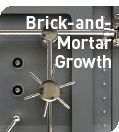“The biggest change in our industry is that fewer and fewer checks are being written every year. ACH and credit and debit card usage has increased by double-digit rates. The Fed is reducing the number of sites where it processes checks, in fact, Kansas City soon won’t even have paper processing. As a result, a lot of our technology investment is converting to electronic versus paper processing,” said Barth.
“We have truly gone from a check-only processing system to an emphasis on debit card processing and e-banking over the past five years,” said Thomas.
These technology changes come at no small price for bankers who are constantly investing in upgrading electronic processing systems, fraud detection, compliance, ATMs and online banking and bill pay systems. Maun reports that his company conducts continual evaluation to make sure backroom processes are efficient. He also states that technology changes, such as the introduction of remote deposit for commercial customers, result in customer service issues and a need to realign staff members so they can spend more time helping customers adapt to the new service.
Maddox predicts another upcoming technology trend: mobile banking in which customers will use text messaging to transact bank business. However, he adds, “we’ll need the ultimate in security to make this work.”

Even though banks continue to consolidate—The American Bankers Association reports that there were 11,970 FDIC institutions in 1995 compared to 8,832 FDIC institutions in 2005—local competition is still on the rise from both new bank charters and non-banks vying for customers by providing traditional banking services. Testament to the fact new banks are still rallying to compete, Bank of Kansas City, a subsidiary of BOK Financial Corporation out of Tulsa, opened a Kansas City branch in November 2006. BOK has, however, done some business in the area dating back to 1998.
“Besides being a contiguous market for us, Kansas City has booming economic development right now, with the Sprint Center, H&R Block headquarters, $4 billion in development outside the urban core and areas such as Olathe and Overland Park being some of the fastest growing cities,” said Maun.
“As more bank branches per capita enter our marketplace, it’s all about satisfying and retaining customers,” said Stu Lang, President of First National Bank. “In general, banking has become more competitive over the past decade. This may be because the capital requirements for entering the market are not onerous, making entrance [into the market] easier.”
Mariner Kemper, Chairman and CEO of UMB Financial Corporation, states that he sees a shift in the focus of banking’s competitive landscape. “Especially on the commercial side the environment has shifted more toward sales and less about partnership and advice,” he said.
“It seems that the only way we can distinguish ourselves is to provide more for free. Yet this also offers the opportunity to be more creative,” said Kemper.

Some banks are placing a lot of emphasis on their ability to serve as financial planning counselors throughout a customer’s stages of life. This approach, combined with the movement toward using the Internet for day-to-day banking transactions, has in many cases changed the purpose for brick-and-mortar locations. Regnier believes that customers are expecting more from their banks in terms of “value-added elements such as financial consulting services.”
“I think banks need to come up with more innovative marketing strategies to attract customers,” said Maddox. “One such innovation at INTRUST is a call-ahead banking service in which customers can call the bank to begin processing any necessary paperwork in order to make their branch experience quicker and easier when they arrive.
Tim Thomas cites that about 40 percent of Bank Midwest customers are using brick-and-mortar locations on a regular basis, making these branches more of a “cross-sell platform” than a place where the focus is on making transactions.
In another attempt to provide value beyond basic products, UMB now offers pod casts on umb.com as a convenient way for customers to tune into financial advice on their own schedule.
“I’m impressed with this and think it’s ahead of its curve, but it makes sense as this will be a major way for people to get information going forward,” said Bank of Blue Valley’s Bob Regnier.

Despite the trend toward on-line transactions and higher ATM usage, brick-and-mortar locations are still relevant. An August 30, 2006, study conducted by the American Bankers Association reported that preferences for where and how to bank had a strong age correlation, with customers age 55 and older preferring branches over both ATMs and online banking, and those younger than 34 preferring online banking the most, with ATMs a close second, and branches being the banking venue they used the least. Local banks are continuing to build new branches. Yet the choice to build new locations may be more strategic than ever before.
“Banks have to be more diligent about where they put their branches and have a greater understanding of customer habits. In our industry more than in any other we have to pick the very best corners,” said Kemper.
As Kemper states, there is still a base of loyal, long-term customers who continue to maintain a steady flow of branch traffic although younger customers are more likely to bank online.
“We still think banking is a very personal business,” said Barth. Commerce will add branches at 135th and Lamar, in North Kansas City and in Lee’s Summit this year and continues to “keep options open” when it comes to buying other banks.
This growth, increased competition and effort to provide more value-added services is of course good news for consumers. For those of us willing to shop around for the best rates and the best advice available, there is a plethora of both available in Kansas City. ![]()
